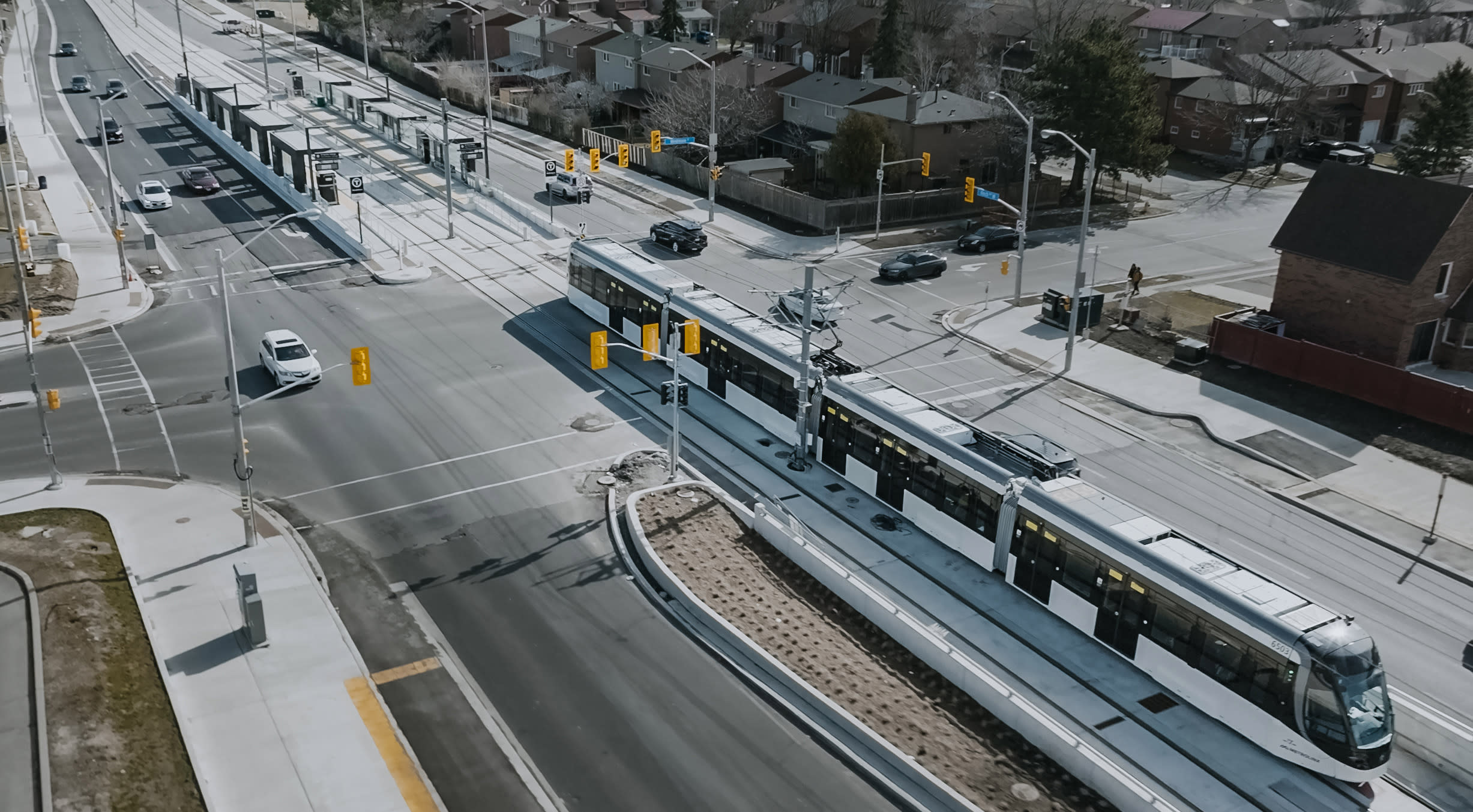Share
LRT safety: Key tips for navigating new light rail transit
Essential safety tips to ensure smooth, safe travels where LRVs operate.
Oct 20, 2025
At Metrolinx, safety is our number one priority, as we continue to bring better, faster and more affordable transit options across the region.
With vehicle testing ongoing for light rail projects like the Line 5 Eglinton (Eglinton Crosstown) and Line 6 Finch West, Metrolinx wants everyone living, working and commuting near these projects to stay safe.
Right in, right out
The “right in/right out” traffic design restricts left turns and through-traffic at cross-streets and driveways on roads that share light rail transit (LRT) guideways.
For example, if you wanted to enter a plaza or driveway, you’re only able to do so by turning right. Why? The design keeps the light rail vehicle (LRV) separate from traffic on the road as much as possible, reducing the risk of incidents and helping ensure fast, frequent service across the entire line.
Drivers are cautioned to keep a close eye on traffic signs and only make U-turns where legally permitted.
Traffic signals vs. transit signals
A new transit line means new traffic signals, changing the way motorists might be accustomed to navigating roadways in areas where LRT tracks are now installed.
Traffic signals for cars and other vehicles on the road will remain in the expected shade of yellow, but transit signals for trains and other transit vehicles are black to set them apart.
Traffic signals for cars and other vehicles on the road will remain in the expected shade of yellow, but transit signals for trains and other transit vehicles are black to set them apart.
Be sure to only make a left turn or a U-turn at crossings with a dedicated left turn signal where permitted. Left turns and U-turns are only permitted when the green arrow is illuminated.
Pedestrian safety: Refuge areas
Crossing the street or boarding an LRT requires a safe place for pedestrians, known as a refuge area. You can find them at every surface stop along LRT routes. They’re also present at intersections with dedicated left turn lanes.
It’s important to note that not all intersections have a stop — meaning there won’t be a refuge area when crossing the road. At those intersections, time your crossing appropriately, and avoid standing on the tracks.
To help keep nearby pedestrians safe, LRVs also offer a variety of audible cues. An alert can be sounded by the vehicle operator to signal the presence of an approaching or moving train, or as a warning to pedestrians who may be too close to the tracks. There is also a louder horn that can be activated when a more vigilant warning to pedestrians and drivers is required.
Pedestrian safety: jaywalking
The installation of light rail stops, tracks and signals also changes the way pedestrians navigate the area.
Be sure to only cross the street at designated crosswalks. Always look both ways and wait for the walk signal.
Any time is train time where rails are present, so never jaywalk, and remember, tracks are strictly off-limits to drivers, cyclists and pedestrians.
Cyclist safety: crossing tracks
For anyone cycling within the LRT corridors, obey traffic laws, exercise caution and use bike lanes. Both Line 6 Finch and Line 5 Eglinton will feature new cycling options. When crossing to the other side of the road, be sure to only do so at designated crossings while observing and obeying traffic and crossing signals.
Always cross rails at a 90-degree angle to avoid bicycle wheels catching or slipping on the metal rails and take extra care when crossing during bad weather such as rain or snow.
As testing and commissioning continues on both Line 5 Eglinton and Line 6 Finch West, it’s important for everyone in the community to stay alert and follow the new rules of the road. By keeping these safety tips in mind, we can all help ensure a smooth transition as these new light rail lines get ready to welcome riders.
by Shane Kalicharan Metrolinx Editorial Content Producer
